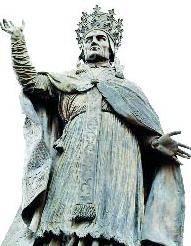Gerbert and a Tenth-Century Robot? February 27, 2018
Author: Beach Combing | in : Medieval , trackbackDid you hear the one about the tenth-century robot created by a pope no less? Several books and authors credit the invention of a talking, walking machine by Gerbert of Aurillac (Pope Sylvester II, obit 1003) and the source is interesting. But, of course, there are no microchips, no nuts and bolts and, in fact, there are no legs.
[Gerbert] cast, for his own purposes, the head of a statue, by a certain inspection of the stars when all the planets were about to begin their courses, which spake not unless spoken to, but then pronounced the truth, either in the affirmative or negative. For instance, when Gerbert would say, ‘Shall I be pope?’ the statue would reply, ‘Yes.’
In the interest of killing ‘cobblers’ it should be noted that most robots are not built by consulting the stars and that this truth-telling ‘brazen head’ has more to do with folklore than with science: in fact, many medieval scientists and magi including Bacon, Virgil (of the medieval imagination), Albert magnus, inter multi alii were said to have built such a head that would tell them the truth, but that would eventually tell them the truth in such a way that it would kill them. Sylvester follows exactly this pattern. He asked the head ‘Am I to die, before I sing mass at Jerusalem?’ ‘No.’ replied the head (‘Moriar antequam cantem missam in Jerusalem’ ‘Non’) But never trust a talking bronze head…
They relate, that he was so much deceived by this ambiguity, that he thought nothing of repentance: for when would he think of going to Jerusalem, to accelerate his own death? Nor did he foresee that at Rome there is a church called Jerusalem, that is, ‘the vision of peace,’ because whoever flies thither finds safety, whatsoever crime he may be guilty of. We have heard, that this was called an asylum in the very infancy of the city, because Romulus, to increase the number of his subjects, had appointed it to be a refuge for the guilty of every description. The pope sings mass there on three Sundays, which are called ‘The station at Jerusalem.’ Wherefore upon one of those days Gerbert, preparing himself for mass, was suddenly struck with sickness; which increased so that he took to his bed: and consulting his statue, he became convinced of his delusion and of his approaching death. Calling, therefore, the cardinals together, he lamented his crimes for a long space of time. They, being struck with sudden fear were unable to make any reply, whereupon he began to rave, and losing his reason through excess of pain, commanded himself to be maimed, and cast forth piecemeal, saying, ‘Let him have the service of my limbs, who before sought their homage; for my mind never consented to that abominable oath.’
Quo illum ambiguo deceptum ferunt, ut nihil excogitaret poenitentiae qui animo blandiertur suo de longo tempore vitae: quando enim Jerosolimam ire deliberaret ut mortem stimularet? Nec providit quod est Romae ecclesia Jerusalem dicta, id est, Visio pactis; quia quicunque illuc confugerit, cuiusunque criminis obnoxious, subsidium invenit. Hanc in ipsius urbis rudimentis Asylum accepimus dictam, quod ibi Romulus, ut augeret ciuium numerum, statuisset omnium reorum refugium. Ibi cantat missam papa tribus Dominicis quibus praetitulatur Statio ad Jerusalem. Quocirca, cum uno illorum dierum Gerbertus ad missam se pararet, invaletudins ictus ingemuit, eademque crescent decubuit; consulta statua, deceptionem et mortem suam cognouit. Aduocatis igitur cardinalibus, diu facinora sua deplorauit: quibus inopinato stupor percussis, nec aliquid referre valentibus, ille insaniens, et prae dolore ratione hebetate, minutatim se dilaniari et membratim foras proici jussit: ‘Habeat,’ inquiens, ‘membrorum officium qui eorum quaesiuit hominium; namque animus meus nunquam illud adamauit sacramentum, imo sacrilegium.
The oath was with the devil, for medieval types liked the idea that their scientists not only were able to do sums but also that they could summon demons.
Now though another question: why do moderns concentrate on Gerbert, instead of other medieval scientists, as the robot maker? This is obscure but three thoughts. First, our sources for Gerbert’s biography are best and the brazen head has been sneaked in as a real automata. Second, there is something aesthetically pleasing about making a pope into a robot pioneer. And, third, anyone with a passing knowledge of Gerbert’s life will know that he constructed mechanical objects (another post, another day). Bronze heads were almost certainly, though, not among his inventions.



